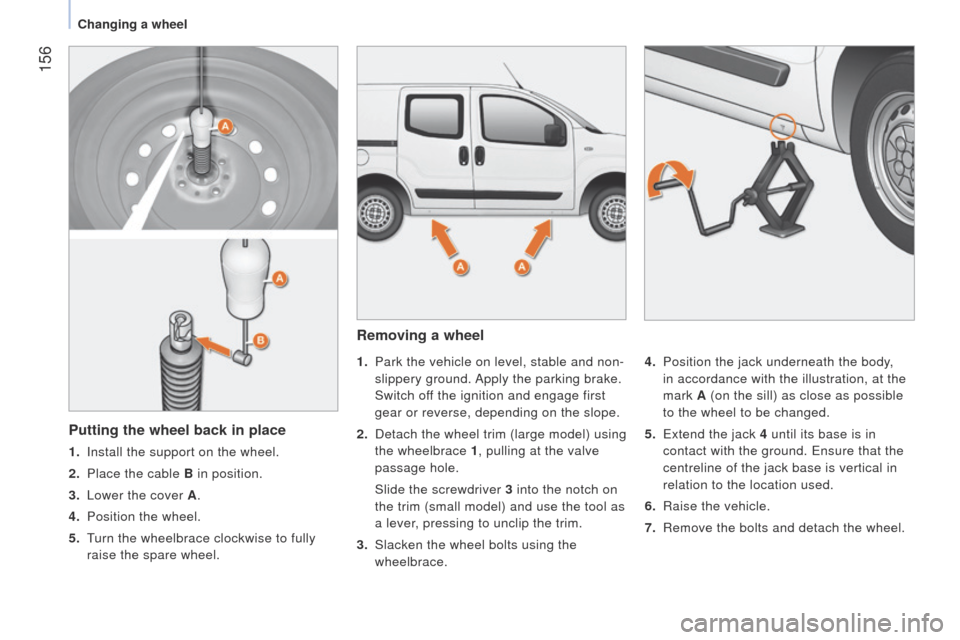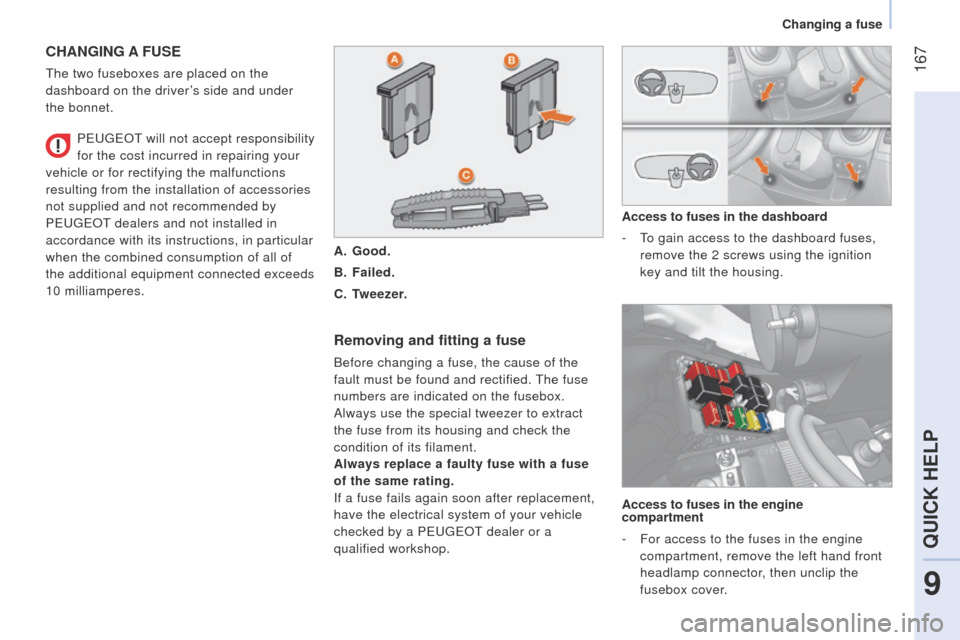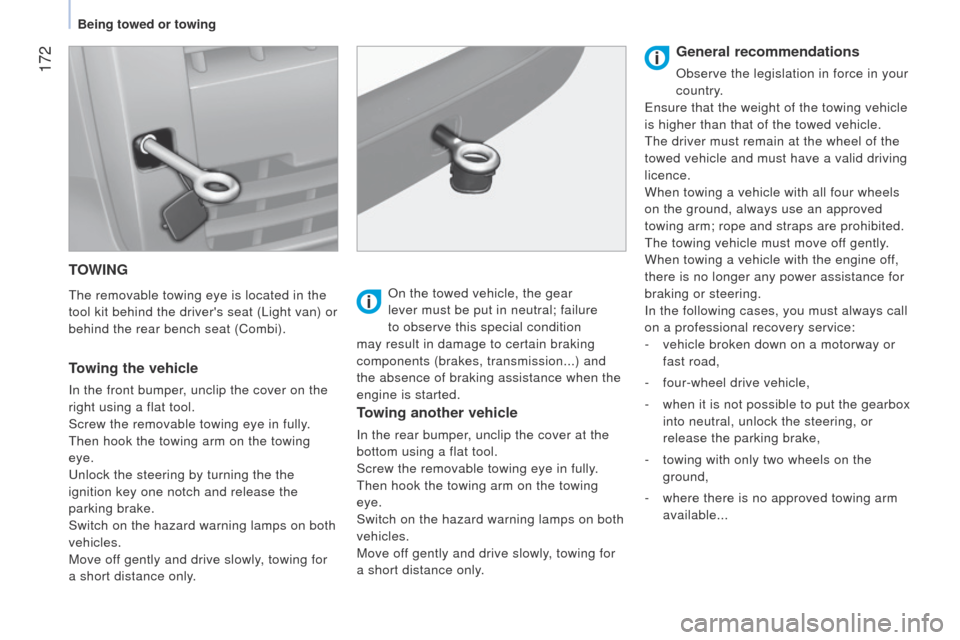2014.5 Peugeot Bipper ignition
[x] Cancel search: ignitionPage 150 of 192

148
Bipper_en_Chap08_verifications_ed02-2014
Engine coolant level
Only use the fluid recommended by the
manufacturer. Otherwise, you risk seriously
damaging your engine. When the engine
is warm, the temperature of the coolant is
controlled by the engine cooling fan. As this fan
can operate with the ignition key removed and
because the cooling system is pressurised,
wait for at least one hour after the engine has
stopped before carrying out any work.
Topping up
t
he level must be between the MIN and
MAX marks on the header tank. If more than
1 litre of fluid is required to top up the level,
have the system checked by a P
euge O t
dealer or a qualified workshop.
Power steering fluid level
the vehicle must be parked on level ground
with the engine cold. u nscrew the cap with
integral gauge and check the level which
must be between the MIN and MAX marks.
Screenwash fluid level
For optimum cleaning and to avoid freezing,
topping up or replacement of this fluid
should never be with plain water; we
recommend the use of products available
from P
euge O t
dealers.
Capacity of the reservoir: approximately
3
litres.
Slacken the cap by two turns to release the
pressure to prevent any risk of scalding.
When the pressure has dropped, remove the
cap and top up the level with coolant.
If fluid has to be added frequently, this
indicates a fault which must be checked by a
P
euge
O
t
dealer or a qualified workshop as
soon as possible.
Used products
Avoid prolonged contact of used oil with the
skin.
Brake fluid is harmful to health and very
corrosive.
Do not dispose of used oil, brake fluid or
coolant into drains or into the ground, but
into the containers provided for this purpose
at P
euge O t
dealers (France) or at an
authorised waste disposal site.
Levels
Page 156 of 192

154
Bipper_en_Chap09_aide-rapide_ed02-2014
Batteries contain harmful substances
such as sulphuric acid and lead.
t
hey
must be disposed of in accordance with the
law and must not, in any circumstances be
discarded with household waste.
take used batteries to an authorised waste
disposal site.
It is advisable to disconnect the battery
if the vehicle is not to be used for a
period of more than one month.
to do
this on models with Stop & Start:
-
press the release button
E
to
disconnect connector F ,
-
disconnect connector
F
of check
sensor G.
t
he presence of this label, in particular
with the Stop & Start system, indicates
the use of a 12 V lead-acid battery with
special technology and specification; the
involvement of a P
euge
O
t
dealer or
a qualified workshop is essential when
replacing or disconnecting the battery.
Failure to observe this recommendation may
cause premature wear of the battery.
After refitting the battery by a
P
euge
O
t
dealer or a qualified
workshop, the Stop & Start system will
only be active after a continuous period of
immobilisation of the vehicle, a period which
depends on the climatic conditions and the
state of charge of the battery (up to about
8
hours). Before charging
t
he charging operation must be carried out in
a ventilated area away from naked flames or
any possible sources of sparks to eliminate the
risks of explosion and fire.
Do not attempt to charge a frozen battery: it
must first be thawed to eliminate the risks of
explosion. If the battery has frozen, before
charging it have it checked by a specialist who
will check that the internal components have
not been damaged and that the container is
not cracked, which could mean that there is a
risk of a leak of toxic and corrosive acid.
Before disconnecting
Never disconnect a terminal when the
engine is running.
Before disconnecting the battery, you must
wait for 2 minutes after switching off the
ignition.
Close the windows and doors before
disconnecting the battery. After reconnecting
After every reconnection of the battery,
switch on the ignition and wait 1 minute
before starting to allow the electronic
systems to be initialised. If difficulties are
experienced after this, contact a P
euge O t
dealer or a qualified workshop.
If the battery has been disconnected
for some time, it may be necessary to
reinitialise the following functions:
-
the display screen settings (date, time,
language, distance and temperature
units),
-
the radio stations,
-
the central locking.
Some settings are cleared and must be
reprogrammed. Contact a P euge O t
dealer
or a qualified workshop.
Never remove the check sensor G
from the
negative battery terminal H , except when
replacing the battery.
Battery
Page 157 of 192

155
Bipper_en_Chap09_aide-rapide_ed02-2014
CHANGING A WHEEL
Parking the vehicle
As far as possible, park the vehicle on level,
stable and non-slippery ground.
Apply the parking brake, switch off the
ignition and engage first gear (on a hill).
It is imperative that you ensure that the
occupants get out of the vehicle and wait in
a safe location.
If possible, place a chock under the
wheel diagonally opposite the wheel to be
changed.
Tools
the tools required are stored in a tool kit
located behind the driver's seat ( l ight van)
or behind the rear bench seat (Combi).
1.
Wheelbrace.
2.
Centre guide.
3.
Screwdriver.
4.
Jack with handle.
5.
Removable towing eye.
t
he jack and all of the tools are specific
to your vehicle. Do not use them for other
purposes.
Never go underneath the vehicle when it is
raised only by the jack; use an axle stand.
Taking out the spare wheel
the spare wheel retaining bolt is located on
the rear left part of the loading sill.
1.
Slacken the wheel retaining bolt using the
wheelbrace.
2.
u nscrew fully to unwind the winch cable.
3.
t
ake out the spare wheel using the
wheelbrace.
4.
Raise the cover
A.
5.
Remove the cable
B from its housing.
6.
Release the spare wheel and place it
near the wheel to be changed.
9
QUICK HELP
Changing a wheel
Page 158 of 192

156
Bipper_en_Chap09_aide-rapide_ed02-2014
Removing a wheel
1. Park the vehicle on level, stable and non-
slippery ground. Apply the parking brake.
Switch off the ignition and engage first
gear or reverse, depending on the slope.
2.
Detach
the wheel trim (large model) using
the wheelbrace 1 , pulling at the valve
passage hole.
Slide the screwdriver
3 into the notch on
the trim (small model) and use the tool as
a lever, pressing to unclip the trim.
3.
Slacken the wheel bolts using the
wheelbrace. 4.
Position the jack underneath the body ,
in accordance with the illustration, at the
mark A (on the sill) as close as possible
to the wheel to be changed.
5.
e xtend the jack 4 until its base is in
contact with the ground.
e nsure that the
centreline of the jack base is vertical in
relation to the location used.
6.
Raise the vehicle.
7.
Remove the bolts and detach the wheel.
Putting the wheel back in place
1. Install the support on the wheel.
2.
Place the cable
B in position.
3.
l ower the cover A .
4.
Position the wheel.
5.
t
urn the wheelbrace clockwise to fully
raise the spare wheel.
Changing a wheel
Page 169 of 192

167
Bipper_en_Chap09_aide-rapide_ed02-2014
CHANGING A FUSE
the two fuseboxes are placed on the
dashboard on the driver ’s side and under
the bonnet.
Removing and fitting a fuse
Before changing a fuse, the cause of the
fault must be found and rectified.
t
he fuse
numbers are indicated on the fusebox.
Always use the special tweezer to extract
the fuse from its housing and check the
condition of its filament.
Always replace a faulty fuse with a fuse
of the same rating.
If a fuse fails again soon after replacement,
have the electrical system of your vehicle
checked by a P
euge O t
dealer or a
qualified workshop. Access to fuses in the dashboard
-
t
o gain access to the dashboard fuses,
remove the 2 screws using the ignition
key and tilt the housing.
P
euge
O
t
will not accept responsibility
for the cost incurred in repairing your
vehicle or for rectifying the malfunctions
resulting from the installation of accessories
not supplied and not recommended by
P
euge
O
t
dealers and not installed in
accordance with its instructions, in particular
when the combined consumption of all of
the additional equipment connected exceeds
10
milliamperes.
A.
Good.
B.
Failed.
C.
T
weezer.
Access to fuses in the engine
compartment
-
For access to the fuses in the engine
compartment, remove the left hand front
headlamp connector, then unclip the
fusebox cover.
9
QUICK HELP
Changing a fuse
Page 173 of 192

171
Bipper_en_Chap09_aide-rapide_ed02-2014
Marking RatingFunctions
F16 7.5 A
e
ngine management control unit - electronic gearbox control unit and gear\
lever -
t
20 relay coil
F17 15 ASupply for ignition coil - injectors - engine management control unit (\
1.3 HDi)
F18 7.5 AEngine management control unit (1.3 HDi) - T09 relay coil
F19 7.5 AAir conditioning compressor
F20 30 ASupply for heated rear screen, electric door mirrors heater elements
F21 15 AFuel pump (1.4 petrol and 1.3 HDi)
F22 20 A
e
ngine management control unit (1.3 HDi)
F23 20 AABS hydraulic block electrovalves supply
F24 7.5 AABS
F30 15 AFoglamps
F81 60 APre-heat unit (1.3 HDi)
F82 30 A
e
lectronic gearbox pump - electronic gearbox supply
F84 10 A
e
lectronic gearbox control unit and electrovalves
F85 30 ACigar lighter - 12 V accessory socket
F87 7.5 A
Reversing lamps - water in Diesel sensor - airflow sensor - T02, T05, T14, T17 and T19 relay coils
(except 1.3 HDi)
5 A Reversing lamps - water in Diesel sensor - airflow sensor - T02, T05, T14, T17 and T19 relay coils -
battery state of charge sensor (except 1.3 HDi)
9
QUICK HELP
Changing a fuse
Page 174 of 192

172
Bipper_en_Chap09_aide-rapide_ed02-2014
TOWING
the removable towing eye is located in the
tool kit behind the driver's seat ( l ight van) or
behind the rear bench seat (Combi).
Towing the vehicle
In the front bumper, unclip the cover on the
right using a flat tool.
Screw the removable towing eye in fully.
t
hen hook the towing arm on the towing
eye.
u
nlock the steering by turning the the
ignition key one notch and release the
parking brake.
Switch on the hazard warning lamps on both
vehicles.
Move off gently and drive slowly, towing for
a short distance only. On the towed vehicle, the gear
lever must be put in neutral; failure
to observe this special condition
may result in damage to certain braking
components (brakes, transmission...) and
the absence of braking assistance when the
engine is started.
Towing another vehicle
In the rear bumper, unclip the cover at the
bottom using a flat tool.
Screw the removable towing eye in fully.
t
hen hook the towing arm on the towing
eye.
Switch on the hazard warning lamps on both
vehicles.
Move off gently and drive slowly, towing for
a short distance only.
General recommendations
Observe the legislation in force in your
country.
e
nsure that the weight of the towing vehicle
is higher than that of the towed vehicle.
t
he driver must remain at the wheel of the
towed vehicle and must have a valid driving
licence.
When towing a vehicle with all four wheels
on the ground, always use an approved
towing arm; rope and straps are prohibited.
t
he towing vehicle must move off gently.
When towing a vehicle with the engine off,
there is no longer any power assistance for
braking or steering.
In the following cases, you must always call
on a professional recovery service:
-
vehicle broken down on a motorway or
fast road,
-
four-wheel drive vehicle,
-
when it is not possible to put the gearbox
into neutral, unlock the steering, or
release the parking brake,
-
towing with only two wheels on the
ground,
-
where there is no approved towing arm
available...
Being towed or towing